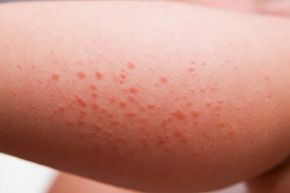It's common knowledge too much sun isn't good for you. In addition to causing painful sunburns, it also puts you at higher risk for skin cancer. Yet, for others, sun exposure can cause another painful condition: sun rash.
Sun rash is an allergic reaction to sunlight. A few different allergies can cause sun rash, the most common being polymorphous light eruption (PMLE), a condition in which skin rashes can develop after fairly limited sun exposure. Other sun allergies that cause sun rash include hereditary PMLE, which is often found in people of Native American descent, and solar urticaria, a rare condition characterized by hives that usually affects young women.
Advertisement
Certain medications can also cause allergic reactions to the sun known as photoallergic reactions. These reactions are caused by the interaction between sunlight and certain ingredients in the medications. Common prescription medications that can cause photoallergic reactions include birth control, antibiotics and antidepressants.
The physical effects of PMLE vary, but they usually take the form of small bumps, redness and itchiness, and sometimes burning, blistering or swelling can occur as well. This rash typically appears on the neck and chest, but it can also show up on the arms and thighs. Other symptoms include chills, headaches and nausea.
PMLE occurs in an estimated 10 to 15 percent of the population and affects people of all races and ethnicities [source: Intelihealth]. People with PMLE typically exhibit symptoms at the same time each year, which is usually in the spring or early summer when sun exposure first occurs.
Read on to learn more about sun rash and how to treat it.
Advertisement


